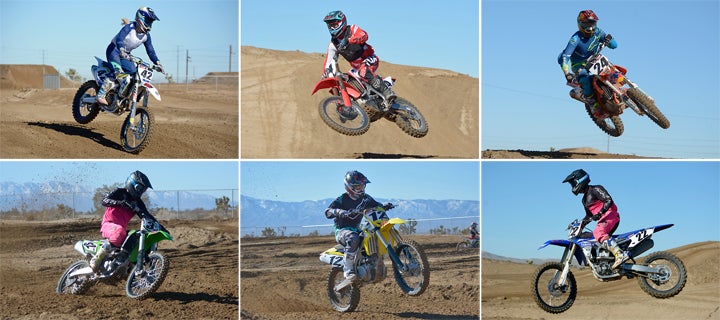
The race to deliver the best 450cc motocross bike on the planet grabbed another gear in 2017 when Honda released its all-new 2017 CRF450R to challenge the recent dominance of Yamaha’s YZ450F and the never-ending onslaught from the aggressive European companies, namely the KTM 450 SX-F and its fully revived sister, the Husqvarna FC 450.
With Kawasaki merely revising its 2017 KX450F after a complete makeover of the green machine in 2016, and with Suzuki holding fast with a 5-year-old yet still-popular design in its 2017 RM-Z450, we figured it was time to round up these six combatants and pit them against each other to see just who is delivering the goods in the 450cc class.
But first a quick caveat: KTM agreed to join our 450cc motocross shootout only with the stipulation that we pit its 450 SX-F Factory Edition against the other machines rather than use its standard 450 SX-F. Why? Simple: KTM’s SX-F test fleet was already depleted, and the $10,399 Factory Edition was all it had available to us. In full disclosure, we polled all of the other OEMs to make sure there would be no cries of “foul!” before agreeing to KTM’s offer. Also, bear in mind that price would be an important factor in our Scorecard criteria.
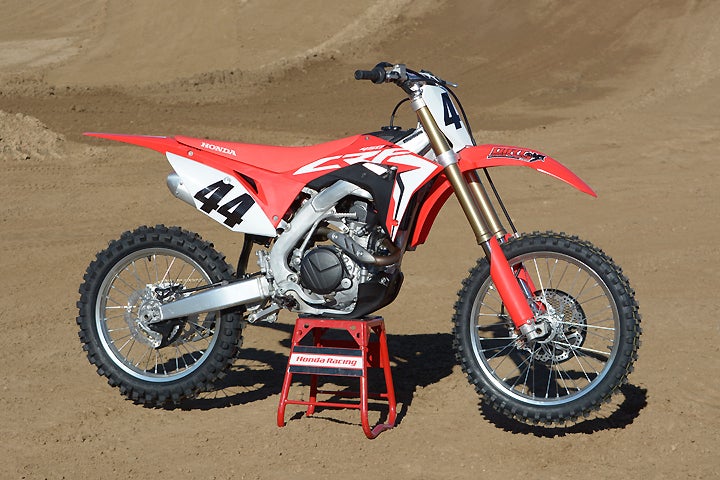
Other than the expectation that the performance of all six machines expected would be razor close, we had no pre-conceived notions about the outcome. The game plan involved a full test day at one of our favorite Southern California tracks, Sunrise MX Park in Adelanto, California. Then, just to be sure of our results, we added a follow-up day at the world famous Glen Helen Raceway in San Bernardino, California—although the rains that have bombarded Southern California made riding Glen Helen as much an exercise in survival as it was a test session. In-between, we weighed and measured these six beauties, flogged them on the dyno and otherwise gathered as many notes as we possibly could to help determine a winner.
We knew it wasn’t going to be easy, as national-winning power and lightning-quick chassis performance may satisfy pro-level riders all day long but might be too much for the average novice to handle. With that in mind, we pulled together a diverse range of rider skill, including DirtBikes.com lead test rider Ryan Abbatoye and DirtBikes.com regular test team member Nic Garvin to represent the pro viewpoint. We also added another Southern California pro in Nick Stover as well as local racer Bryan Burch to offer up the perspective of the Intermediate/Expert-level amateur. In a unique twist, we think, we also invited veteran motojournalist Jean Turner to deliver impressions on behalf of both females and novice-level riders. The plan was to find the best machine for every rider, and we were supremely confident that our Scorecard points ranking system, borrowed from our brothers at Motorcycle.com, would get the job done nicely.
Our team focused on five key talking points when ranking these beastly machines: Engine Performance, Suspension Performance, Handling, Braking Performance and Ergonomics. Our comprehensive Scorecard also addressed details such as price, model features such as electric start and engine management control and the overall cool factor in determining our winner. What follows is the collective thoughts of our test team, which we want to thank for doing such an awesome job of taking notes to codify their thoughts about each bike. We also want to point out that these impressions appear in alphabetical order of the machine’s make and thus do not reflect rank of a particular bike in a particular category.
So let’s get on with it!
ENGINE PERFORMANCE
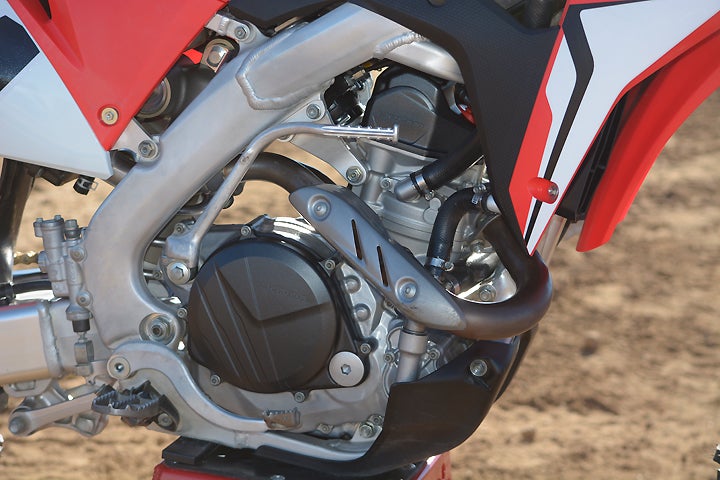
Fact is, while there are many details that make up a winning 450cc machine, engine performance ranks right up at the top. The manufacturer that can build not only the most power, but the most rideable power, will often have an advantage on the track. With horsepower levels now topping 60 ponies at the crankshaft, getting all that gallop to the ground is of prime importance. Thus, every machine in the class now makes use of sophisticated fuel-injection and adjustable engine mapping controls in various forms to help mete out the power to suit rider abilities and skill levels.
For 2017, Honda completely revamped the CRF450R engine, making it the most powerful CRF yet. The Honda’s fuel-injected Unicam SOHC engine boasts a new cylinder head, a new piston that raises the compression ratio to 13.5:1 and a new downdraft intake layout to help ram the air into combustion chamber for increased power. A new, more gradually bent exhaust system is also used to increase power. The Honda also makes use of a revised Engine Mode Select button system that allows the rider to alter the power characteristics by accessing three preset maps with the touch of a button. The CRF also has the ability to accept an optional electric start, although our test unit retained the standard kick start. Its five-speed transmission is engaged via a cable-actuated clutch.
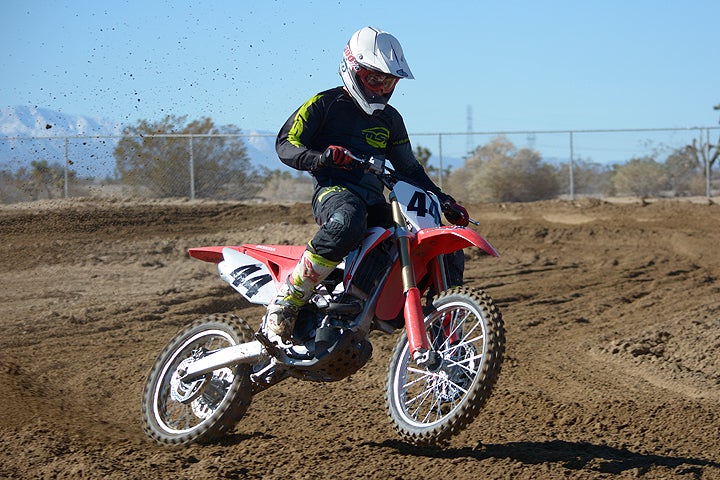
On the track, all of our riders agreed that the new CRF engine delivers a level of excitement of which the previous model was simply not capable. The Honda delivers serious punch right at the hit of the throttle, and it pulls long and hard all the way through its rev range—it simply doesn’t go flat. It’s also extremely tractable.
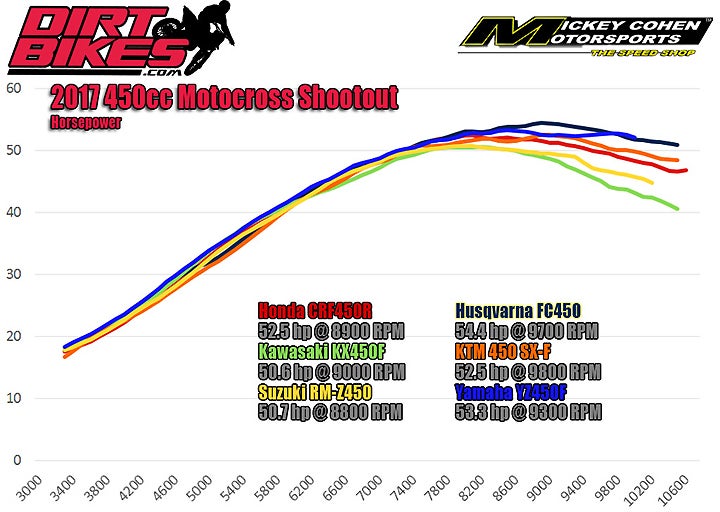
“The Honda motor is awesome,” Abbatoye said. “It has strong power when you need it, but it is also smooth for the average rider. It simply doesn’t run out of power on long straights. It pulls all the way to its rev limiter. I noticed a little hesitance in its fuel-injection, and yet sometimes it’s too responsive. The Honda’s clutch and shift action are also perfect for me.” Garvin added that one of the CRF’s highlights is that the engine is brawny yet smooth. “The power build is amazing,” he said. “It comes in strong right off the bottom and just keeps pulling and pulling and pulling, and the transmission is buttery smooth. The fuel-injection gives the bike good throttle response without being too aggressive as well.”
Stover and Burch also agreed, noting that the CRF is strong and useable at any rpm. Even our novice tester dug the CRF’s engine character.
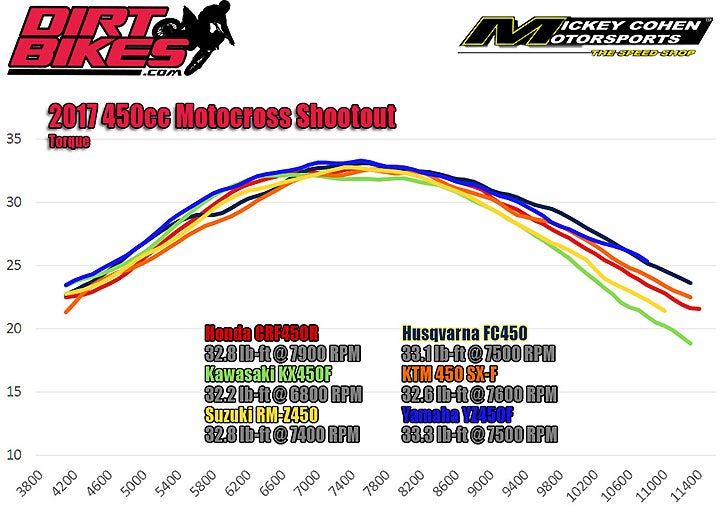
“Wow,” Turner said of the CF450R’s power delivery. “The motor is nice, free-revving. Kind of loud? Multiple maps. The motor is quite potent. Power was very smooth, however, and manageable for a novice. It also flamed out kind of easy. It was the only bike I stalled on the track (I noticed another rider also had a flame-out on the CRF). Good thing it starts easy, but I would definitely want the electric-start option if I were to buy this bike.”
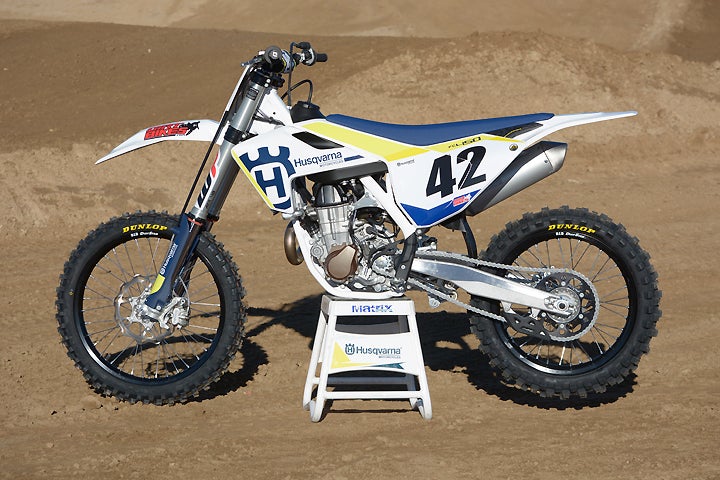
Being owned by the same conglomerate that owns KTM has been both a blessing and a curse for Husqvarna. The blessing is that the hallowed brand has received all of the support necessary to bring the brand back to the prominence it enjoyed from the 1960s through the 1980s. The curse is that many fans perceive the Husky FC 450 to simply be a KTM of another color. While it’s true that the two share a lot of awesome engineering details—they both feature convenient electric start, sophisticated traction control and adjustable engine mapping systems that are accessed with the simple push of a button—their engines are supposedly tuned identically, and their five-speed transmissions and hydraulically actuated clutches are also identical. Even so, our test crew found that the 2017 Husqvarna FC 450’s fuel-injected, SOHC engine performed quite a bit differently than the supposedly identical KTM 450 SX-F Factory Edition engine on the track, and there was some disagreement among our pros as to just how well it performed.
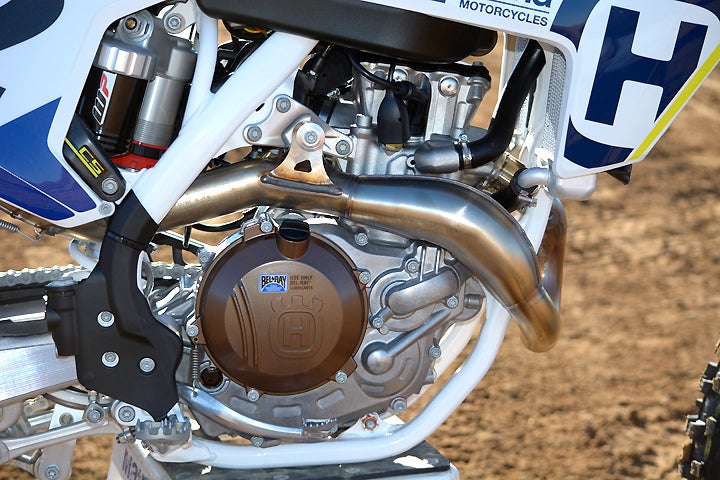
“For all the power it supposedly makes, the Husqvarna doesn’t feel all that fast to me,” Abbatoye said, confirming Garvin’s similar desire for a Husky engine with more pep. “The engine has a lively feel, but I had to ride it harder to go fast compared to the others. I think that part of it might be the throttle response, which felt a little slow to me. I also feel that the Husky vibrated more than some of the other bikes in this shootout. As far as the clutch and transmission go, I had no issues except maybe feeling like I was a little in-between gears in some spots on the track. I liked the aggressive ignition map the best.”
That differed quite a lot from Turner’s novice perspective, where she called the Husqvarna’s power “almost deceptive.”
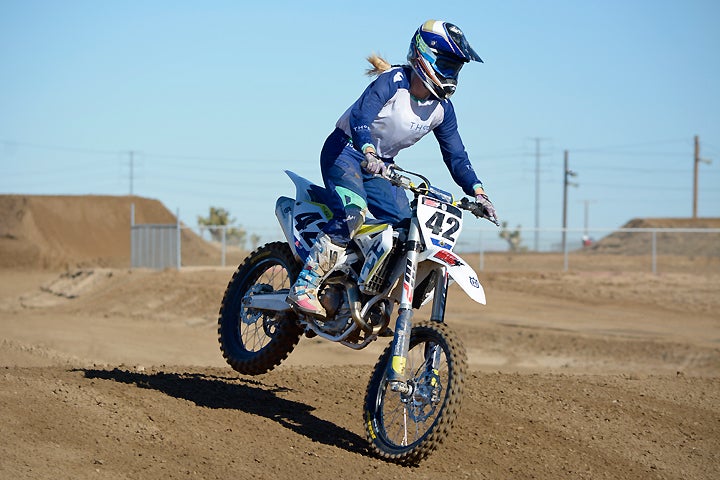
“The power comes on in a very well-behaved manner off the bottom,” she said. “Roll-on is strong and manageable, but touch that clutch when you’re coming out of turns, and boom! Here comes the eye-popping torque! It gripped the ground in such an impressive way. Wheel-spinning power is easy to come by, but ground-gripping power isn’t easy to produce.”
Burch also felt that the FC 450 was strong and consistent throughout the rev range, but he did express a complaint that more than one member of our test crew also noted with regard to the Husky’s shifter.
“It’s one of my favorites as far as power delivery goes,” Burch said. “I also thought that the transmission was well-spaced for motocross, but it was hard to find the shifter with my boot to upshift and downshift it.”
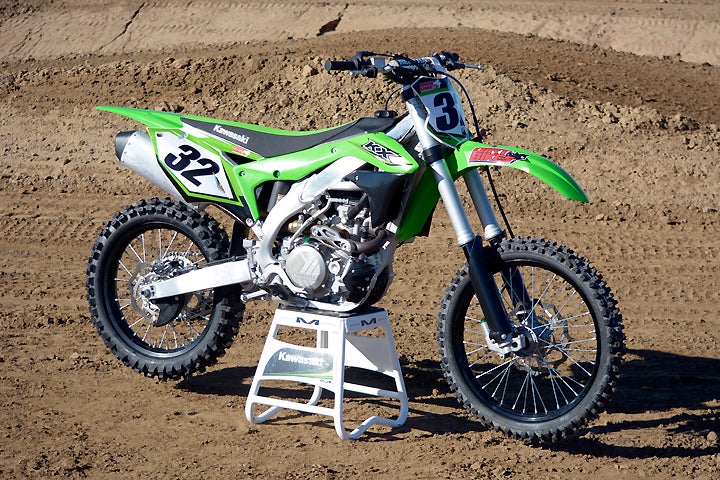
The Kawasaki KX450F underwent its last major revision in 2016, with Kawi serving up a lighter, faster version of the KX’s fuel-injected DOHC engine. The KX received all-new engine cases, new intake porting, new intake valves and higher-lift camshafts along with a new air box design to help the engine breathe better. Kawi engineers also went with a new piston and a new exhaust system to enhance power, most notably from midrange to redline. That engine is back for 2017 along with Kawasaki’s Launch Control holeshot assist and adjustable ignition mapping that is altered by swapping to different plug-in DFI couplers. Like the rest of the Japanese contenders, the KX features a five-speed transmission and cable-actuated clutch.
While the KX450F motor still feels lively, the majority of our test crew was looking for more bite to go along with the bark of the Kawi’s exhaust note.
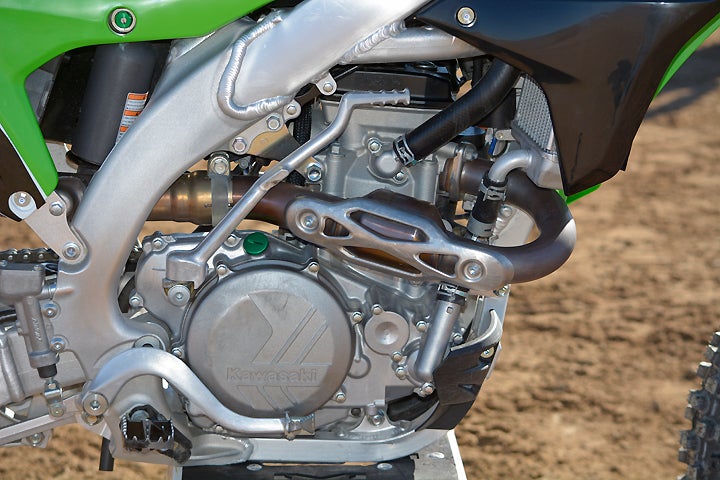
“It’s strong and clean down low, but it flattens out way too early, and its throttle response is not the best in this class either,” Stover said. “The transmission is smooth, but at times I wasn’t sure of the engagement.”
Garvin was even harsher in his description of the KX’s power.
“The top end is weak,” Garvin said. “The bike has decent grunt off the bottom, but there’s a difference between the sound it makes and its actual power response. It’s weird because the throttle response is there, but it just needs more power. You have to work harder on the Kawasaki than you do on some of the others to maintain a fast pace. At least it shifts smoothly.”
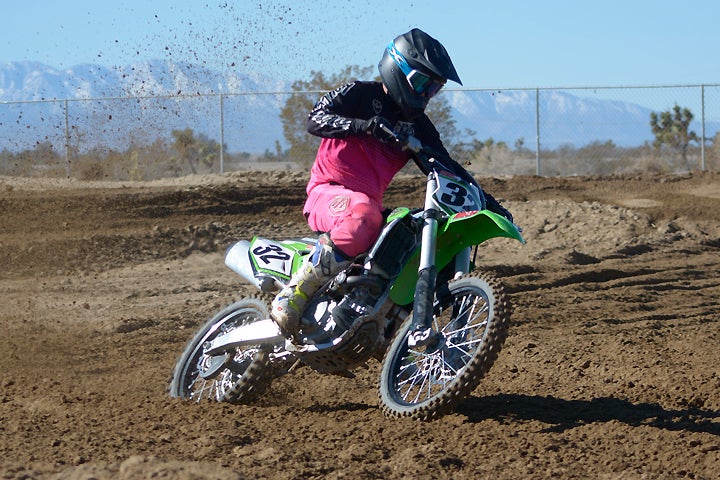
Abbatoye noted that switching to the leanest of the Kawasaki’s plug-in power couplers helped add a measure of throttle response, but then the KX developed a tendency to pop under deceleration. Kawasaki’s tech offered to let us try a custom-mapped coupler. It reduced the pop but did nothing to enhance the Kawasaki’s power. But, truth be told, our crew is over the whole plug-in power coupler method of adjusting the engine mapping on the Kawasaki and Suzuki. It’s time for both brands to get up to speed with Honda, Husqvarna, and KTM by fitting a handlebar-mounted mode switch that does away with the couplers, which can be easily misplaced at the track of left at home.
Intermediate/Expert representative Burch agreed with the overall consensus of the group.
“The KX feels pretty lively, but it isn’t the fastest,” Burch said. “It has good throttle response but there’s just no snap to the power delivery. I also think that the transmission was geared a little too tall. Shifting was on the harsh side for me.”
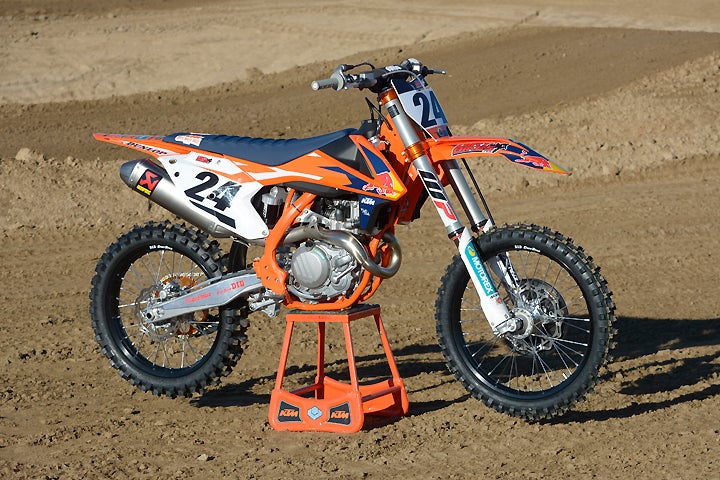
In reality, other than its high-end finish details and outrageous price tag, the KTM 450 SX-F Factory Edition is identical in spec to the standard 450 SX-F. In addition to offering customers a bona fide “factory replica,” the real idea behind the Factory Edition is to give KTM the opportunity to introduce changes that will eventually make their way onto the standard SX-F, so the Factory Editions are, technically speaking, “2017.5” SX-Fs.
Other than the pipe, there are no changes to the KTM’s, electric-start, fuel-injected SOHC power package or selectable-map engine management system. The KTM makes use of a hydraulically activated clutch to help riders mete out power through its five-speed transmission.
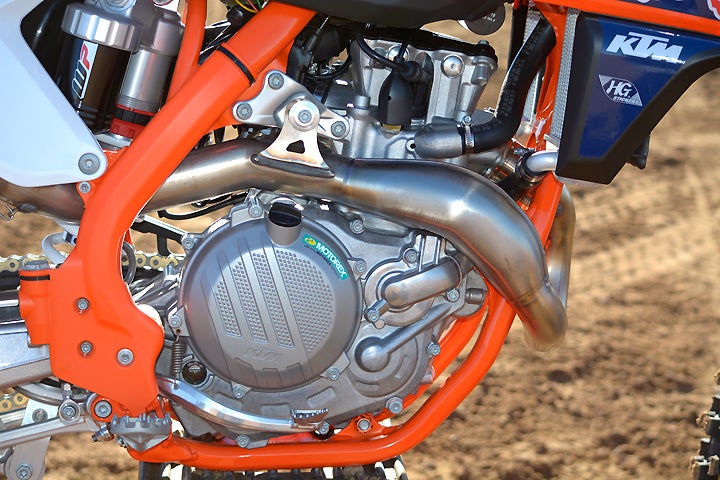
Like we said earlier, the KTM is supposed to be tuned the same as the Husqvarna, but the KTM’s power character was a whole lot different than the Husky’s. Like the Honda, the orange rocket was unanimously appreciated by all of our testers.
“The KTM is really fast,” Abbatoye said. “Throttle response is a little on the dull side, but the engine is so fast that it hardly matters, and the KTM doesn’t lose any steam on top. I actually liked the stock ignition map the best. Like the Husky, the KTM’s clutch and shifting action are smooth.”
Garvin also rated the KTM engine highly, noting that there was a more distinct difference between the engine maps on the KTM than on the Husky. “Of its two maps, the first one is smooth down low and fast up top,” he said. “The number two map was smooth until you got past quarter throttle, and then it felt a lot more aggressive. On the other hand, I had trouble shifting KTM, and I would definitely look at a sprocket swap because I found myself in-between gears a lot.”
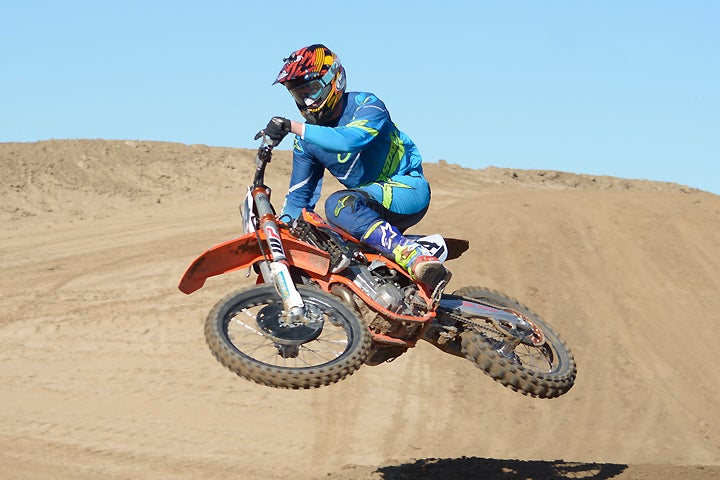
Stover added that the KTM delivers “smooth and controlled power,” while Burch called it “a strong engine package.”
“On the track, the KTM is just as fantastic,” Turner said. “The motor is very refined, yet also a brute, making big power when you’re ready for it. Roll-on is smooth and non-intimidating, even for a novice, but it will quickly ramp up the speed and come on incredibly strong, especially with a flick of the clutch. What makes it so potent is its ability to put the power to the ground.”
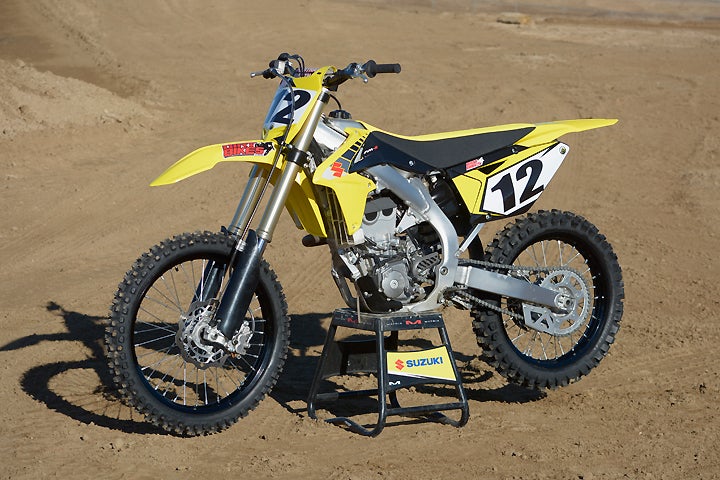
Despite the fact that the Suzuki RM-Z450 hasn’t undergone a redesign since 2015, Suzuki has been more than just making do with its big and mellow yellow machine. On its own merit, the Suzuki is a great bike, possessing a fun and easy-to-ride DOHC engine with nearly flawless fuel-injection/throttle response, and a chassis that can turn like a corkscrew. In 2015, Suzuki enhanced the RM-Z by lightening the chassis, revising the suspension and updating the ECU by adding the Suzuki Holeshot Assist Control (SHAC), giving riders even more control when trying to get the Suzuki out of the starting gate. The Suzuki also makes use of DFI couplers to swap various ignition maps that alter the Suzuki’s power character. One minor complaint is that the Suzuki’s kickstarter is awkward, although the bike will fire up pretty easily.
Still, as much as all of our testers liked the Suzuki, its power simply isn’t up to snuff with the newer bikes in the class. That came through loud and clear from our testers.
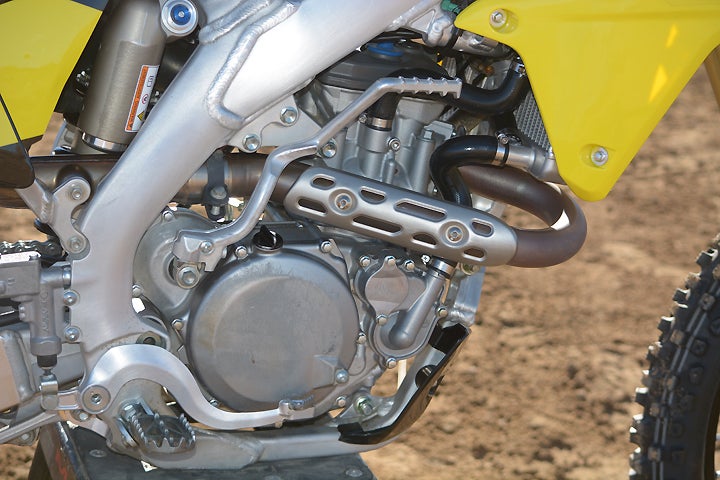
“The Suzuki makes smooth power, but it’s not the fastest bike in the class,” Abbatoye said. “It has decent bottom end, but the power really drops off quickly. Its throttle response is very responsive, maybe the best of any 450, but as lively as the engine feels, it’s still slow compared to the competition. Its clutch and shifting action are good. I had no issues other than that I had to shift the RM-Z a lot more than the other bikes.”
Garvin was a little more forgiving. “She’s an old motor, but she’s still a strong motor,” he said. “You have to work to keep up with the other machines in the class, but its power is steady and smooth, nothing crazy. Throttle response is smooth, but the overall engine character lacks aggression. I’m glad it shifts well because you have to rev it and pull a lot of shifts.”
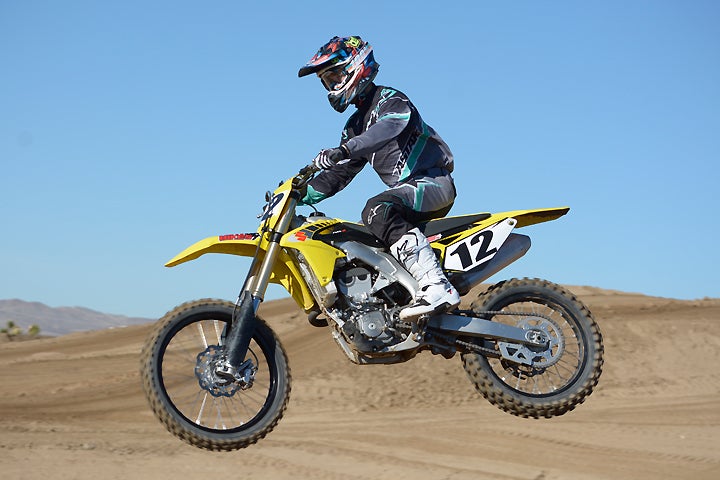
Stover was not as excited, stating that the Suzuki’s power “is fairly uninspiring, but at least it makes the RM-Z450 easy to ride.” Burch called it the “the weakest of the bunch” and “kind of dull, really mellow, but easy to ride” while also praising the Suzuki’s five-speed transmission by noting how easily it shifted especially at high revs.
But for novices, it’s a different story.
“Reeeeeally liked the motor on this one,” an enthusiastic Turner said. “It comes on smooth and steady off the bottom, and has a nice hit in the midrange. It feels like the stock exhaust probably holds it back a little. The motor might be a bit of a Labrador among pit bulls, but for the novice rider, there’s no such thing as a 450 without enough power! Shifting and clutch feel are very good.”
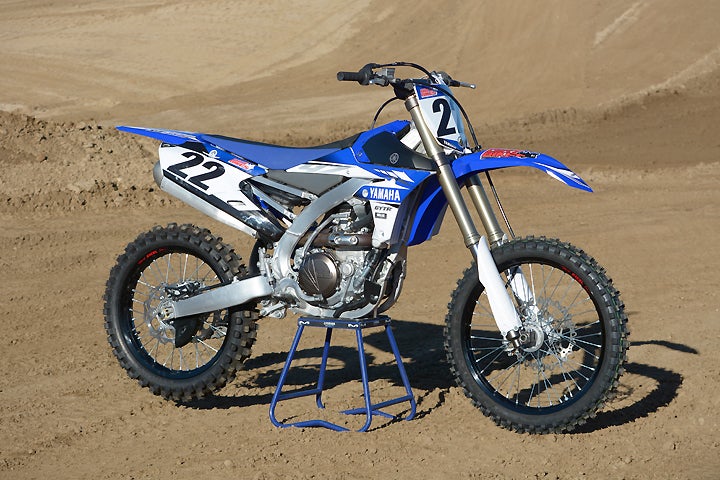
It’s no secret that the Yamaha YZ450F has been one of our favorite motocross bikes for the past couple years. The reverse incline-motored blue bomber is unique, and it has easily had the most powerful-feeling motor in the class for the past couple seasons. Compared to the rest of the class, the YZ’s fuel-injected DOHC Single is sort of a brute, although its aggression can be altered by plugging in Yamaha’s accessory GYT-R tuner and adjusting the fuel mapping parameters. The YZ450F doesn’t feature electric start, although a mounting boss for the starter is found on the YZ engine cases since the YZ450F and the electric-start WR450F and YZ450X share the same cases.
Regardless of the YZ’s brawny power character, it’s clear that some of the competition has been working hard to catch up. So how does the Yamaha’s engine performance fare against the latest crop of 450s?
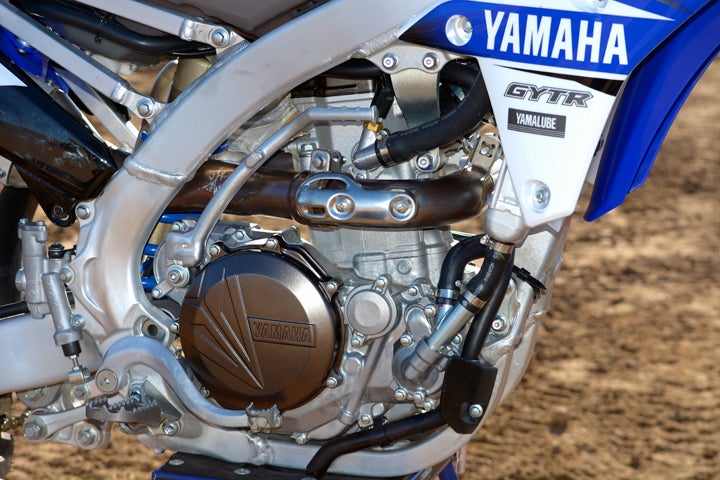
“The Yamaha is definitely still one of the fastest 450s,” Abbatoye said. “It has the power you need when you need it. The YZ is easy to ride because you can run it in a taller gear and it still pulls well. It can tractor around the track all day, yet it’s lively and fast with excellent throttle response. I really had no issues with its transmission and clutch action, and I really didn’t have to shift it as much.”
Garvin agreed, adding, “It is really responsive. Love the cable clutch action, and its shifting action is smooth and easy.” Turner was also onboard with the Yamaha engine, at first, noting that “the motor just pours on power everywhere, and without really trying, you’re just floating down straights and over jumps. It’s fast-revving, very responsive and crisp. It’s exciting, but it’s also a challenge to hang on to.”
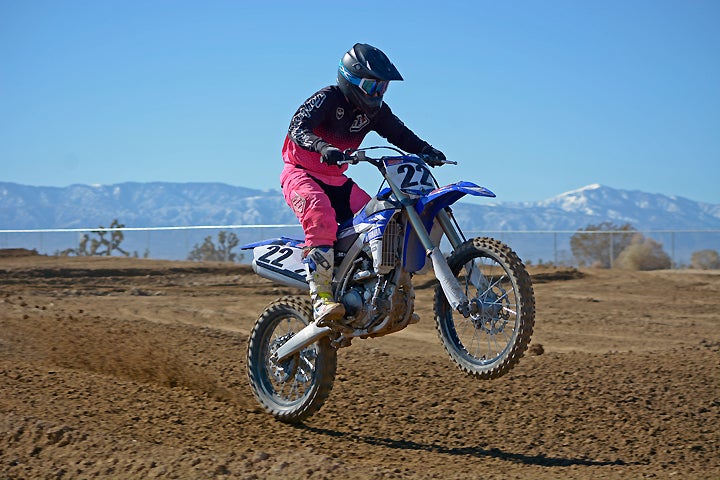
That tapped into something Stover said: “The Yamaha is aggressive, but it can become tiring to ride,” and Turner later added. “The power is a bit much. KTM/Husky and Honda prove that you can have massive power that is also manageable. I don’t feel like the Yamaha’s power is as manageable.”
 Your Privacy Choices
Your Privacy Choices